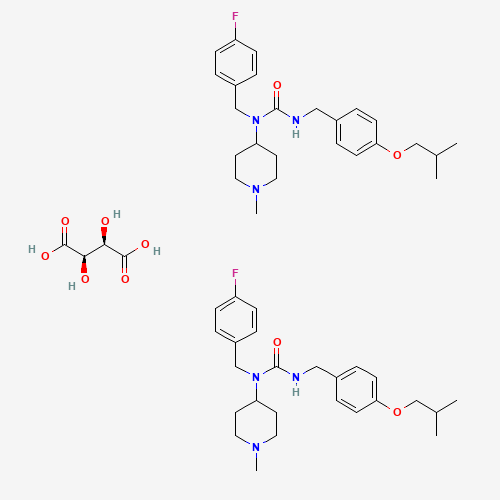| Pharmaceutical Information |
| Drug Name |
Pimavanserin tartrate |
| Drug ID |
BADD_D01772 |
| Description |
Psychotic symptoms associated with Parkinson's disease (PD) are relatively common, reducing quality of life and prognosis for individuals with PD.[A232783]
Pimavanserin (ACP-103), marketed under the trade name Nuplazid, is a drug developed by Acadia Pharmaceuticals for the treatment of psychosis related to Parkinson's disease. Due to its actions at serotonin receptors and lack of effects on dopamine receptors, pimavanserin treats hallucinations and delusions without causing extrapyramidal symptoms.[A232613] It was initially approved by the FDA in 2016 and is now under review as a potential treatment for dementia related psychosis. As of April 2021, FDA approval has not been granted for this indication, despite previous breakthrough designation.[L32913] |
| Indications and Usage |
Pimavanserin is indicated for the treatment of hallucinations and delusions associated with Parkinson’s disease psychosis.[L32883] |
| Marketing Status |
approved; investigational |
| ATC Code |
N05AX17 |
| DrugBank ID |
DB05316
|
| KEGG ID |
D08969
|
| MeSH ID |
C510793
|
| PubChem ID |
11672491
|
| TTD Drug ID |
DDI6B0
|
| NDC Product Code |
17205-098; 20076-0002; 70966-0018; 67651-0210; 63090-340; 63090-100; 11014-0420; 67651-0325; 67651-0336; 69766-056; 64552-4081; 11014-0350; 17381-103; 73435-002 |
| UNII |
NA83F1SJSR
|
| Synonyms |
pimavanserin | N-(4-fluorophenylmethyl)-N-(1-methylpiperidin-4-yl)-N'-(4-(2-methylpropyloxy)phenylmethyl)carbamide | ACP 103 | ACP103 | ACP-103 | Nuplazid | pimavanserin tartrate | urea, n-((4-fluorophenyl)methyl)-n-(1-methyl-4-piperidinyl)-n'-((4-(2-methylpropoxy)phenyl)methyl)-, (2R,3R)-2,3-dihydroxybutanedioate (2:1) | bis(1-(4-fluorobenzyl)-1-(1-methylpiperidin-4-yl)-3-(4-(2-methylpropoxy)benzyl)urea) (2R,3R)-2,3-dihydroxybutanedioate |
|
| Chemical Information |
| Molecular Formula |
C54H74F2N6O10 |
| CAS Registry Number |
706782-28-7 |
| SMILES |
CC(C)COC1=CC=C(C=C1)CNC(=O)N(CC2=CC=C(C=C2)F)C3CCN(CC3)C.CC(C)COC1=CC=C(C=C1)CNC
(=O)N(CC2=CC=C(C=C2)F)C3CCN(CC3)C.C(C(C(=O)O)O)(C(=O)O)O |
| Chemical Structure |

|
|
| ADRs Induced by Drug |
|
|
*The priority for ADR severity classification is based on FAERS assessment, followed by the most severe level in CTCAE rating. If neither is available, it will be displayed as 'Not available'.
**The 'Not Available' level is hidden by default and can be restored by clicking on the legend twice..
|
|
|

